
|
|
Primary Sources: Crucible of Free Speech
Fighting for Democracy | A Night in Bohemia | Free Speech for the Masses |
|
| Fighting for Democracy |
Sanitary Drinking Cup,
Socialist Party Presidential Campaign of 1912
Newberry Library: May Walden Papers
Socialist leader Eugene V. Debs ran for president of the United States five times between 1900 and 1920, the last time from federal prison, where he was incarcerated for his antiwar sentiments. In 1912 the Socialist Party reached its high water mark, winning nearly a million votes. Playing off the growing popularity of personal �hygienic cups� intended to replace communal drinking cups used on trains and in other public places, Chicagoan May Walden conceived the idea for this cup as a fundraising novelty during the 1912 campaign. On the reverse side of the cup is the slogan, �A Clean Cup for Clean Politics.� back to top
|
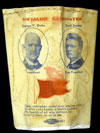
 |
|
�The Garment Workers� Strike,� in
The International Socialist Review
Chicago: Charles H. Kerr & Co., November 1915
Newberry Library: J 2617 .422
Agnes Nestor�s National Women�s Trade Union League Convention Badge, 1922
Chicago Historical Society:
Decorative and Industrial Arts Collection
In 1910 and 1915, tens of thousands of Chicago garment workers, many of them young immigrant women, took to the streets to protest their working conditions. Many of the female leaders of the strike were affiliated with the Women�s Trade Union League (WTUL), a national organization that sought better conditions for working women through unionization and education.
Chicagoan Agnes Nestor, who worked as a glove maker at Eisendrath Glove Company, became president of the WTUL Chicago branch in 1913. She wore this badge to a WTUL convention in Waukegan. First headquartered at Hull-House and later at the Chicago Federation of Labor, the WTUL embraced the difficult challenge of bringing working-class women like Nestor together with reform-minded middle-class women. back to top |
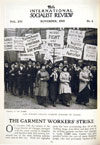
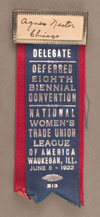

Agnes Nestor, Chicago Women�s Trade Union League leader, 1928
Chicago Historical Society: Prints and Photographs Collection
|
|
Man Ray
�Capitalism, Humanity, Government,� in Mother Earth
New York: Emma Goldman, August 1914
Newberry Library: J 2617 .617
Chicago�s anarchist community participated in a national and international debate about the nature of state power in modern society. This cover of Emma Goldman�s Mother Earth magazine, drawn by the Dada artist Man Ray, depicts humanity torn apart by capitalism and government, each a different manifestation of the same monstrous reality. Although published in New York City, Mother Earth reported regularly on the activities of Chicago anarchists, and Goldman spent a good deal of time in the city.
back to top
|
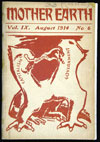 |
|
Socialist Party Buttons, c. 1905
Chicago Historical Society: Decorative and Industrial Arts Collection
Industrial Workers of the World Lapel Stud, c. 1905.
Chicago Historical Society: Decorative and Industrial Arts Collection
Political organizers used a variety of buttons, badges, and pennants to identify themselves with their cause. Buttons produced by the Socialist Party of America show hands clasped across a globe. The slogan �Workers of the World Unite� was drawn from the last lines of the Manifesto of the Communist Party by Karl Marx and Friedrich Engels.
The Industrial Workers of the World (IWW) adapted the Socialists� globe symbol for their own lapel pins. Founded in Chicago in 1905, the IWW advocated �one big union� of all workers, regardless of race, gender, or occupation, and the �abolition of the wage system.�
back to top
|
|
�Joe Hill�s Funeral,� in The International Socialist Review
Chicago: Charles H. Kerr & Co., January 1916
Newberry Library: J 2617 .422
The Industrial Workers of the World (IWW), a militant union, used songs to help supporters articulate their problems and to popularize the organization�s proposed solutions. In November 1915, thousands of supporters attended the Chicago funeral of IWW songwriter Joe Hill, who was executed by firing squad in a Utah prison. According to his supporters, Hill was falsely convicted of murder.
The Swedish immigrant was best known for songs such as �The Rebel Girl� and �The Preacher and the Slave,� which gave new political lyrics to popular or traditional tunes. IWW organizers sang these and other songs during a series of �free speech fights� across the American West that forced local officials to allow the union to conduct street meetings.
back to top
|
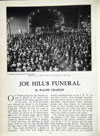 |
|
John McCutcheon
Liberty Bond Mutual Benefit Association, 1917
Newberry Library: John T. McCutcheon Papers
The U.S. entered Europe�s Great War in 1917 as a deeply divided nation. To rally the country to the cause of war, the federal government launched a massive public relations effort drawing on the most talented communicators in business, journalism, and government. In this advertisement from the Chicago Tribune of October 1917, popular cartoonist John T. McCutcheon encourages Americans to support the war effort by purchasing government bonds. With the letters �US� in the background, a circle of men representing different occupations is united by Liberty Bonds. The poster suggests that only un-American outsiders would refuse to support the bond drive. back to top
|
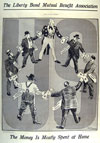 |
|
Anti-War Dance, 1918
Newberry Library: Dill Pickle Club Records
Chicagoans organized many protests against American involvement in World War I, including this �Anti-War Dance� sponsored by the bohemian Dill Pickle Club. Critics of the war charged that large manufacturers were the most likely to profit from the war while workers were the most likely to die in the trenches. The war deeply divided Chicago�s radicals. Some believed that it was necessary to remain loyal to the government once Congress declared war. Others argued for active resistance to mobilization and conscription.
back to top
|
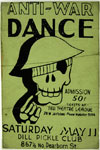 |
|
Chicago Federation of Labor
�Terrorism,� in The New Majority
Chicago, January 10, 1920
Newberry Library: Case Oversize HD6500 .N5
In coordinated raids organized by Attorney General A. Mitchell Palmer across the nation during January 1920, federal and local law enforcement officials arrested thousands of radicals, trade union militants, and immigrants. Officials warned that this breach of civil liberties was necessary because radicals were plotting to overthrow the government. In response, the Chicago Federation of Labor�s newspaper attacked Palmer�s Red Raids as employer-inspired retribution for the massive strikes that had paralyzed industry during 1919.
back to top
|
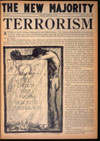 |
|
Clarence Darrow
Argument in Defense of the Communists
Chicago: Charles H. Kerr & Co., 1920
Newberry Library: ZZ Volume 24 no. 2
Among those arrested in January 1920 were twenty members of the Communist Labor Party, one of two newly formed left wing parties that emulated the revolutionary example of the Russian Bolsheviks. Charged under a wartime sedition law, the Communists faced long jail terms. In their defense, well-known civil liberties attorney Clarence Darrow argued that the government targeted the Communists for their beliefs rather than any criminal activities.
back to top
|
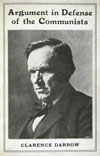 |
|
Press Club of Chicago�s Anti-Red Mass Meeting, 1920
Chicago Historical Society: Library Collection
The Press Club of Chicago invited attorney Frank D. Comerford to discuss the �most Dastardly Conspiracy in the History of the World,� Bolshevism. Just a month prior to the lecture promoted in this flyer, Comerford had successfully convicted twenty communist and socialist organizers in Chicago�s famous �Communist Trial.� Civil libertarian Clarence Darrow served as the communists� attorney. All twenty of the convicted men were arrested during Attorney General A. Mitchell Palmer�s Red Raids. After Comerford�s legal triumph, he was considered an expert on the �peril of Bolshevism.�
back to top
|
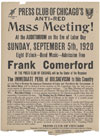

Frank Comerford, prosecuting attorney in Chicago�s Communist Trial, prepares Ole Hanson for his testimony, Chicago, 1920. Hanson, Seattle�s mayor during the 1919 general strike, testified to Bolshevism�s spread throughout the country.
Chicago Historical Society: Prints and Photographs Collection |
|
| A Night in Bohemia |
The Dill Pickle Lending Library, n.d.
Newberry Library: Dill Pickle Club Records
�Step High, Stoop Low, Leave Your Dignity Outside:�
Entrance to the Dill Pickle Club, 18 Tooker Alley, n.d.
Newberry Library: Dill Pickle Club Records
Among Chicago�s most unusual contributions to the culture of modern urban life was the Dill Pickle Club, located at 18 Tooker Alley just east of Bughouse Square. Operating as a coffeehouse, art gallery, and speakeasy, �The Pickle� welcomed hoboes, prostitutes, professors, and every variety of nonconformist passing through Chicago. The club hosted weekend jazz dance parties and little theater productions of Strindberg, Ibsen, O'Neill, and local playwrights. It hosted serious lectures by university professors and spoof debates staged for pure entertainment. In its early years, the Pickle was a meeting place for some of Chicago's most famous authors, intellectuals, and radicals, including Carl Sandburg, Sherwood Anderson, Floyd Dell, Clarence Darrow, Ben Reitman, Lucy Parsons, Ralph Chaplin, Ben Hecht, Harriet Monroe, and Vachel Lindsay.
back to top
|
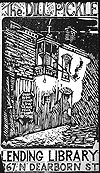
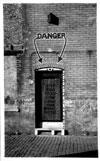 |
|
Stanislaw Szukalski
Jack Jones
Ink and charcoal drawing on paper, 1919
Newberry Library: Dill Pickle Club Records
The Dill Pickle Club was the brainchild of Jack Jones, pictured here in a portrait by Polish immigrant artist Stanislaus Szukalski. A Canadian by birth, ex-Industrial Workers of the World member, part-time painter, and full-time cultural entrepreneur, Jones managed his club from 1914 to 1931. His friend and collaborator Szukalski maintained a studio near the Pickle and became known as a leading Chicago modernist painter and sculptor.
In 1923 Ben Hecht�s Chicago Literary Times said of Szukalski �He is the answer to the pin wheel modernism of the decade.� Szukalski drew this portrait of Jack Jones for the Wednesday book page of the Chicago Daily News in the summer of 1919.
back to top
|
|
A Night in Bohemia: The Dill Pickle Masked Ball, 1916
Newberry Library: Dill Pickle Club Records
Bring Your Witch to the Halloween Masquerade, n.d.
Newberry Library: Dill Pickle Club Records
Dill Picklers in Costume: Barbary Coast Costume Ball
from right to left, top to bottom: (Lillian?) Collie, Maxwell Bodenheim, Ann Mitchell, Jack Jones, Minna Bodenheim, Esther Lobe, Jerry, [December 31, 1919]
Among the most popular Dill Pickle Club events were its frequent masquerade balls. These events appealed to a broad range of partygoers, allowing wealthy residents of the Gold Coast to mingle in relative anonymity with working people and artists. Masquerade balls also attracted gay men and women. Under cover of the party, women could dress as men and men as women. With so many people cross-dressing, few took notice of same sex couples. Although the Dill Pickle Club closed early in the 1930s, citywide Halloween Balls continued to be meeting places for gay men and women into the 1940s.
back to top
|
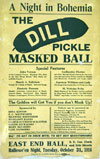

|
|
Ben Hecht
Fantazius Mallare: A Mysterious Oath
Chicago: Covici-McGee, 1922
Newberry Library: Case MacAdams 76
The sexual subject matter and illustrations of Ben Hecht�s novel Fantazius Mallare caught the eye of post office censors when it arrived in 1922. Federal authorities later charged Hecht and his illustrator with obscenity, to which they pleaded "no contest." The Chicago Daily News journalist was a regular at the Dill Pickle Club during the early 1920s and later gained national fame as a screenwriter.
During the 1920s Hecht also published the Chicago Literary Times, an eclectic collection of parody and commentary on Chicago�s artistic and literary personalities, and mainstream cultural institutions. Commenting on the quality of Chicago journalism, Hecht wrote �The reading matter of the newspaper is not the voice of the people but the comforting assurances of the institutions within which people hide from themselves and one another.�
back to top
|
|
First Annual Abstract Art Exhibit
Palette & Chisel Club Scrapbook, May 1915
Courtesy of the Palette & Chisel Club
�There is no slavish repetition of form or color scheme existing in nature. Color riots, line and shape are in a state of anarchy.� So concluded one journalistic account of the Palette & Chisel Abstract Art Show of 1915 that included, among others, a painting said to represent a speech by President Wilson.
Modern art first came to Chicago with the Armory Show of 1913 that featured mainly European artists. Cultural conservatives criticized the show as vulgar and obscene. The Palette & Chisel Club, founded in 1895 as an artists� cooperative, was one of the few venues for Chicago artists influenced by modernism. Originally located in the Atheneum Building, the club moved to 1012 N. Dearborn in 1921.
back to top
|
|
Dill Pickle Event Notices [c. 1916-33]
Newberry Library: Dill Pickle Club Records
This sampling of notices from the Dill Pickle Club suggests the range of topics that attracted audiences to the Club: free love, anarchy, anti-obscenity laws, and Zionism mixed with dancing, drama, and psychology.
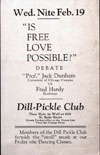 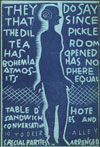 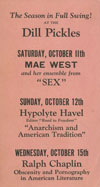
back to top
|
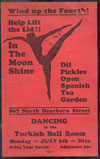
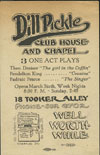 |
|
Ben Reitman, Making the Grade in the Jazz Age, 1928
Newberry Library: Dill Pickle Club Records
This notice of a lecture series led by Dr. Ben L. Reitman at the Dill Pickle Club illustrates how some bohemians sought to use their social clubs as educational venues. Reitman was a long-time fixture in Chicago�s bohemia. As a physician he worked closely with society�s outcasts, especially prostitutes and venereal disease patients. In 1907 he organized the city�s first of several �Hobo Colleges� for transient workers. In the 1910s he had managed the lecture tours of anarchist Emma Goldman, became her lover, and was tarred and feathered by a San Diego mob. Later he helped Jack Jones organize lectures at the Dill Pickle Club. Reitman hoped his educational efforts would help young people, especially new arrivals to the city, live more open and productive lives.
back to top
|
|
Chicago's Interracial Debating Classic, January 25, 1931
Newberry Library: Pullman Company Archives
Before the advent of television, lectures and debates provided public entertainment. Social activists used these venues to present their ideas and to educate their constituencies. This flyer promotes a debate involving A. Philip Randolph and Chandler Owen, both leaders of the Brotherhood of Sleeping Car Porters (BSCP), as �optimists,� and Ben Reitman and David Tullman, both white radicals associated with the Dill Pickle Club, as �pessimists.� Although the exact topic of the debate is unclear, both sides supported unionization as well as racial integration. In 1931, the BSCP was engaged in a campaign to gain formal recognition as the union of African American porters and maids who worked on Pullman sleeping cars.
back to top
|
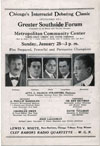 |
|
| Mary MacLane, �I Await the Devil�s Coming,� January 31, 1901
Mary MacLane, [1903]
Newberry Library: Stone & Kimball Records
Nineteen-year-old Mary MacLane from Butte, Montana, may have been the original flapper. She wrote �I Await the Devil�s Coming� and sent it to Chicago�s Stone and Kimball Company. When it appeared in print in 1902, re-titled The Story of Mary MacLane, the book sparked controversy with its references to the author�s sexual longings. Literary critics proclaimed it a work of refreshing openness, while more traditional readers thought it improper for a young woman. For a time, her name became synonymous with female sexuality. MacLane went on to write several other books and to act in early films, one based on her book Men Who Have Made Love To Me. Never married, MacLane lived in Chicago until her death in 1929.
back to top
|
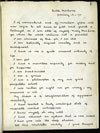
![Mary MacLane, [1903]](../exhibitimages/2b15tn.jpg)
|
|
James Trembath
The Liberty Belle � She�s Cracked, n.d.
Newberry Library: Dill Pickle Club Records
In the early twentieth century, some women adopted new fashions, opinions, and manners of speech that mainstream Americans often regarded as sexually provocative. Stereotypically, these flappers wore short skirts, bobbed hair, smoked cigarettes, drank liquor, and were loose with men. As this cartoon indicates, Chicago�s bohemia became associated with these fashions. A woman dressed in flapper fashion delivers a speech from a soapbox. She points to a sign reading �Liberate the Libido,� a reference to the growing popularity of the work of Austrian psychoanalyst Sigmund Freud who argued, in part, that repressed sexual feelings could manifest themselves in antisocial behavior. A handwritten note at the bottom of the cartoon comments: �A typical scene at the Dill Pickle Club.�
back to top
|
 |
|
Margaret Sanger�s Chicago Speaking Engagements in
The Little Review
Chicago, April 1916
Newberry Library: Case A 5. 5299
Margaret Sanger
What Every Girl Should Know
Girard, Kansas: Haldeman-Julius Co., [1922 or 1923]
[originally published 1912-1913]
Case HQ57 .S28
In 1913 and 1914 New Yorker Margaret Sanger published several articles on birth control, venereal disease, and women�s rights that resulted in federal obscenity charges against her. When the charges were dropped in 1916 Sanger toured the country giving lectures promoting birth control. Chicagoan Margaret C. Anderson, editor of The Little Review, was an ardent supporter of birth control, and used her magazine to promote Sanger�s lectures.
The pamphlet What Every Girl Should Know is a compilation of Sanger�s early articles, some of which had been suppressed by the post office. By the 1920s, the federal government loosened its enforcement on mailing birth control information, although the obscenity laws were not formally overturned until the 1960s.
back to top
|
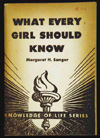 |
|
Announcements for Lectures by Elizabeth Davis and
Magnus Hirschfeld, 1931
Newberry Library: Dill Pickle Club Records
Although Chicago�s bohemian clubs were known as welcoming to gay men and women by the 1920s, discussion of homosexuality was rarely as direct as these two notices from the Dill Pickle Club. Chicagoan Henry Gerber founded the Society for Human Rights in 1923, but the organization made little headway. Gay men and women continued to be subject to police harassment, and Illinois law criminalized homosexuality until 1961. Elizabeth Davis was a regular at the Dill Pickle Club, and reputed to be a �woman hobo� who traveled from town to town seeking out adventure. The notices on either side of this card are typical of the way the Dill Pickle Club�s proprietor Jack Jones used sensational titles to publicize events.
back to top
|
 
|
|
Magnus Hirschfeld
�Sexual Reform on a Scientific Basis,� in Earth
Wheaton, Illinois: March 1931
Newberry Library: A 5 .287
Magnus Hirschfeld, an openly gay German physician, was a long-time advocate of human rights for sexual minorities. He founded the Scientific Humanitarian Committee in 1897 to advocate for the decriminalization of homosexuality in Germany and the World League for Sexual Reform on a Scientific Basis in 1928. He fled Germany after the rise of Adolph Hitler, and the Nazis burned the extensive library at his Berlin clinic. Hirschfeld�s lecture at the Dill Pickle Club in 1931 was said to have drawn a record-breaking crowd of over 300. During his stay in Chicago, the editors of Earth, a small-circulation literary magazine published in Wheaton, Illinois, interviewed Hirschfeld and featured him prominently in their March 1931 issue.
back to top
|
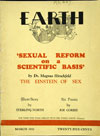 |
|
| Free Speech for the Masses |
The International Socialist Review
Chicago: Charles H. Kerr & Co., October 1915, November 1915, February 1916
Newberry Library: J 2617 .422
The flagship publication of Chicago�s Charles H. Kerr Publishing Company, the International Socialist Review (ISR), was among the most widely read socialist magazines of the early twentieth century. Avoiding the dry theorizing of many political journals, the ISR featured colorful and provocative cover art, photography of strikes and rallies, and articles written by rank-and-file participants in the socialist and labor movements. It also regularly reported on world politics and economics. An ardent supporter of the Industrial Workers of the World, and a voice for the antiwar wing of the Socialist Party, the ISR ceased publication in 1918 after it became a target of post office censorship.
back to top
|
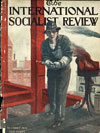
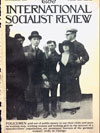
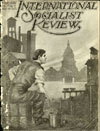
|
|
WCFL Broadcasting Facilities, 1930
Chicago Historical Society: Library Collection
The Chicago Federation of Labor saw radio as an opportunity to communicate with its members, and to publicize the values of the labor movement. Community-oriented stations lost listeners when corporate radio consolidated its control over the best frequencies. In a speech before the U.S. House of Representatives, Republican Frank R. Reid of suburban Chicago protested big radio�s domination of the airwaves, claiming that the �Radio Monopoly Menaces Free Speech.� Reid hoped the U.S. Department of Labor would step in to protect labor-oriented stations.
back to top
|
 |
|
WCFL Program: Formal Dedication of Radio Stations, 1931
Chicago Historical Society: Library Collection
In 1926, the Chicago Federation of Labor created and operated radio station WCFL, known as the �Voice of Labor,� to inform and organize Chicago�s working class. Events and festivities detailed in this program to dedicate the new Michigan Avenue studios in 1931 included Irish, Jewish, Lithuanian, and Polish-themed performances.
back to top
|
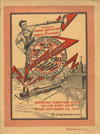 |
|
Crystal Set Radio, c. 1920
Chicago Historical Society:
Decorative and Industrial Arts Collection
In its early years radio was an untested and uncontrolled technology. Corporations and community groups vied for the best frequencies, and many listeners were hobbyists who built their own receivers. Crystal sets like this one were the first radios created for broadcast reception. They were very popular during the 1920s when radio stations around the country, including Chicago�s labor radio station WCFL, began broadcasting. These radios were cheap, needed no battery, and could be built quickly. This homemade crystal set consists of a painted cardboard container designed to house a wire coil and lead ore �crystal� known as a �galena.� back to top
|
|
45th National Labor Day Celebration Button, 1927
Chicago Historical Society:
Decorative and Industrial Arts Collection
46th National Labor Day Celebration Poster, 1928
Chicago Historical Society:
Prints and Photographs Collection
During the 1920s and 1930s, Chicago�s labor-movement radio station WCFL renewed local interest in celebrating Labor Day by sponsoring elaborate events at Soldier Field. WCFL hoped to bring together Chicago�s workers in a spirit of solidarity while they watched performances, including circuses, sports, music, fireworks, and car races. The gatherings were designed to be fun and political, offering a pro-labor version of the growing world of commercial entertainment available to working-class Chicagoans. For those who could not attend, WCFL broadcast the festivities. The Chicago Federation of Labor reasoned that stronger identification of workers and their families with the labor movement would reinforce workers� voices in the workplace and at the ballot box.
back to top
|

Labor Day celebration at Soldier Field sponsored by WCFL labor radio station, 1927
Chicago Historical Society: Prints and Photographs Collection
|
|
Illinois Workers Alliance
Demonstrate for Adequate Cash Relief
Chicago, 1936
Newberry Library: Graham Taylor Papers
In the depths of the Great Depression nearly 25 percent of the American workforce was unemployed. Many struggled alone, feeling isolated and disempowered. In Chicago and other large industrial cities, �unemployed councils� gave voice to the frustrations of the victims of the Depression. Often organized by radicals, the councils demanded increases in relief payments, fought evictions, and illegally turned on gas and electric supplies to poor families cut off by utility companies. The Chicago Commons settlement house worked with the Socialist Party� affiliated Illinois Workers Alliance to protest a reduction in relief payments.
back to top
|
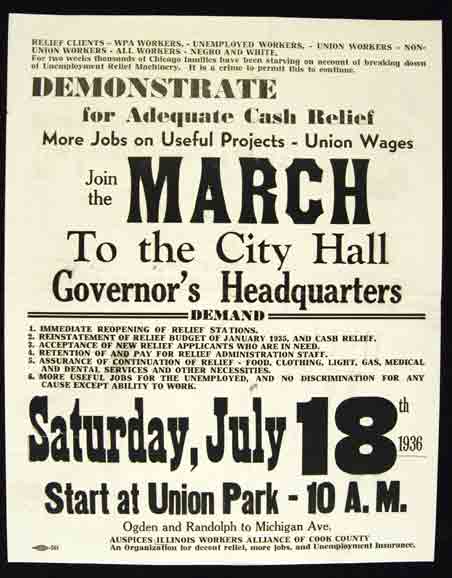 |
|
Labor Rally at Du Sable High School, May 9, 1937
Newberry Library: Pullman Company Archives
Report from Mrs. M. Butler to E.M. Graham, May 11, 1937
Newberry Library: Pullman Company Archives
Unionization will advance the cause of all African Americans. So said Brotherhood of Sleeping Car Porters (BSCP) leader A. Philip Randolph at Du Sable High School in 1937, according to the Pullman Company informant who attended the meeting. Chicago�s Pullman Company was a major employer of African Americans and enjoyed a reputation for paternalism toward its workers, providing good wages and an Employee Representation Plan that the company promoted as an alternative to independent unions. Beginning in the mid-1920s the BSCP worked to unionize the porters and maids working in Pullman�s sleeping cars. Like other Chicago companies, Pullman maintained an extensive network of informants who infiltrated unions and reported back to management.
back to top
| 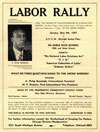 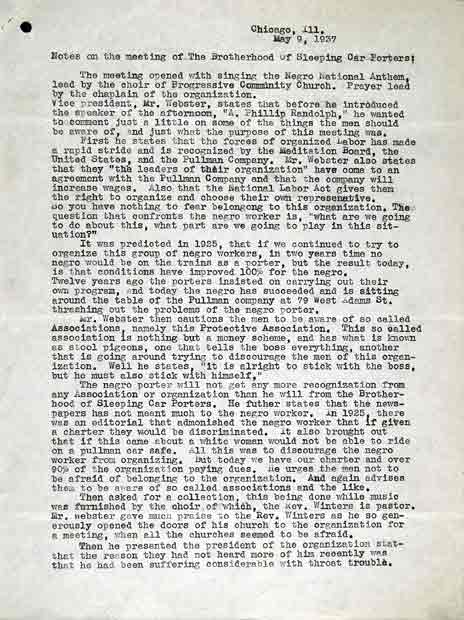
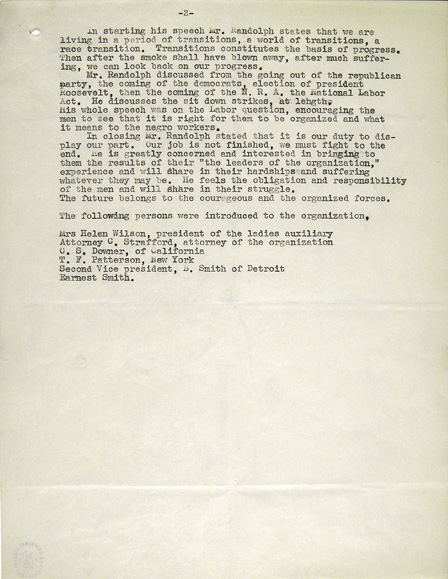
|
|
Steel Workers Organizing Committee Dues Book, 1938-39
Chicago Historical Society:
Archives and Manuscripts Collection
Steel Workers Organizing Committee Button, c. 1938
Chicago Historical Society:
Decorative and Industrial Arts Collection
Beginning in 1936, the Steel Workers Organizing Committee of the newly formed Congress of Industrial Organizations unionized workers throughout the steel mills on Chicago�s Southeast Side. Organizers used dues booklets like this one from U.S. Steel�s South Works to keep track of which workers had paid their monthly dues. After paying dues, workers received a button indicating they were paid-up members. This system kept organizers in frequent contact with rank-and-file workers, and the buttons created a visual presence for the union within the noisy mills, while serving as a daily act of free speech.
back to top
|
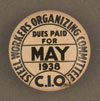 |
|
Lupe Marshall Confronts Chicago Police During the
Memorial Day Massacre, 1937
Chicago Historical Society: Prints and Photographs Collection
On Memorial Day 1937, striking Republic Steel workers, their families, and union organizers picketed the mill on the city�s Southeast Side. Chicago police responded with handguns and clubs, killing ten strikers. This event has ever since been known as the Memorial Day Massacre. Lupe Marshall, shown here helping the wounded, along with two hundred other women, marched with the steelworkers on Memorial Day. Police accused Marshall, a Mexican immigrant who worked at Hull-House, of throwing a bag of pepper at the police during the Massacre. She was kicked, arrested, convicted, and fined $12 for conspiracy to commit an illegal act.
back to top
|
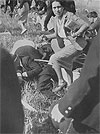 
|
|
Estupendo Festival, 1937
Chicago Historical Society: Archives and Manuscripts Collection
Strike Bulletin Women�s Auxiliary, 1937
Chicago Historical Society: Archives and Manuscripts Collection
On Memorial Day 1937, Chicago police opened fire on striking steelworkers near the Republic Steel mill on Chicago�s Southeast Side. The police killed ten strikers and wounded thirty others in what became known as the Memorial Day Massacre. As these flyers illustrate, steelworkers and their communities mobilized in many ways to support the strike. Mexican steelworkers organized a "Fantastic Festival" celebrating the Mexican revolution, a symbol of resistance. The Women�s Auxiliary of the Steel Workers Organizing Committee supported the strike by picketing and cooking meals for the strikers.
back to top
|
|
The Anvil
New York, May-June 1935
Newberry Library: Case A 5.068
Jack Conroy, 1936
Newberry Library: Jack Conroy Papers
Nelson Algren under the Chicago El, c.1939
Courtesy of Douglas C. Wixson
The Anvil, edited by Jack Conroy from 1933-35, was known for its commitment to publishing the work of aspiring working-class and left-wing authors during the worst years of the Great Depression. Conroy was a celebrated �proletarian writer� whose 1933 semi-autobiographical novel The Disinherited detailed the lives of poor workers. Although The Anvil benefited from the support of the Communist Party, Conroy clashed with party leaders and lost editorial control of the magazine in 1935. In Chicago, Conroy and Nelson Algren brought out the New Anvil for several issues in the late 1930s, but the magazine never regained its earlier energy. Algren went on to win the National Book Award for his novel, The Man with the Golden Arm.
back to top
|
|
Richard Wright
�Child of the Dead and Forgotten Gods,� in The Anvil
[Moberly, Missouri]: March-April 1934
Newberry Library: Case A 5 .068
When Richard Wright was a young postal clerk in Chicago, he became involved with the Communist Party�s John Reed Club. Encouraged in his literary aspirations by the Club, he published poems in its journal Left Front in early 1934. Shortly afterward, Wright published two poems in Jack Conroy�s Anvil�his first publication in a magazine of national circulation. Wright went on to write the best-selling novels Native Son and Black Boy. His books were condemned by some white politicians for their frank treatment of the horrors of segregation. The FBI briefly considered charging Wright with sedition early in the 1940s, and from 1942 until his death in 1960 it monitored his activities, although he left the Communist Party early in the 1940s.
back to top | 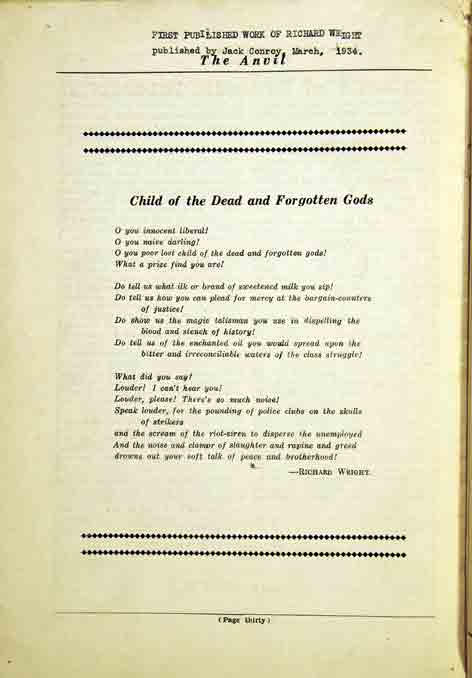 |
|
South Side Community Art Center, n.d.
Courtesy of Douglas Wixson
An outgrowth of the Federal Art Project, the South Side Community Art Center was a meeting place for young African American writers and artists during the 1940s. Brought together by a desire to make their work relevant to the social problems facing members of their community, many were also linked to interracial political and artistic projects.
Seated (left to right): Margaret Brundage, Tom Conroy, Ferne Gayden, Gwendolyn Brooks, Margaret Burroughs; standing (left to right): Marion Perkins, Vernon Jarrett, Robert Lucas. Not pictured, but also associated with this group were Richard Wright, Arna Bontemps, and Frank Marshall Davis.
back to top
|
|
�Writers Mobilize Against Fascism,� in The Anvil
New York, May-June 1935
Newberry Library: Case A 5 .068
By the mid-1930s, many liberals and radicals worried that antidemocratic political movements were gaining the upper hand throughout the world. Hints of homegrown fascism could be seen in the violent repression of strikes, the popularity of Huey Long of Louisiana, and the anti-Semitic and anti-radical Father Coughlin of Detroit. Aligning themselves with the Communist Party and the Soviet Union�which they perceived as a bulwark against fascism�many artists and writers became part of a coalition known as the �Popular Front� that aimed to stem the growth of conservative influence in the U.S. In later years, as the antidemocratic policies of the Soviet Union became more obvious, this Popular Front fell apart.
back to top | 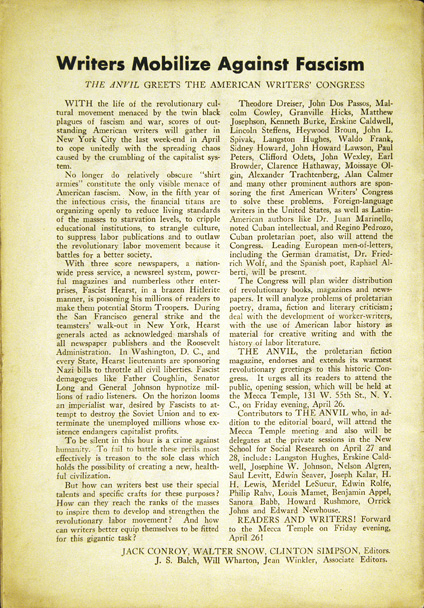 |
|
Jos� Renau Montoro
Campesino, Defiende con las Armas al Gobierno que te Di� la Tierra
[Madrid?]: Ministerio de Agricultura, [1936?]
Newberry Library: Wing 8F ZP 940 .G7
In 1936, Spanish voters elected a left-wing government. In response, Spanish conservatives launched an insurrection that would bring General Francisco Franco to power in 1939. Although the U.S. government maintained neutrality toward the conflict, American radicals rallied to the Spanish forces loyal to the elected government. Several thousand Americans joined the �Abraham Lincoln Brigade� and fought on the front lines of what they saw as an emerging world conflict between fascism and democracy. Chicago writer and editor Jack Conroy saved this poster to recall his support for the antifascist cause. Issued by the elected Spanish government, it calls on Spanish farmers to seize the property of landlords who have joined the insurrection.
back to top
|
|
213 Days Without Bail: Demand Bail for Katherine Hyndman!, c.1953
Chicago Historical Society: Library Collection
The Case of Irwin Franklin, c. 1953
Chicago Historical Society: Library Collection
Katherine Hyndman and Irwin Franklin became targets of post-World War II anticommunism. While living in Chicago, the Russian-born Franklin sold Soviet-made films during the 1930s and 1940s. He was arrested and ordered deported in 1953 for his �subversive� activities.
Gary, Indiana, resident Katherine Hyndman, a Croatian immigrant, was repeatedly jailed for her membership in the Communist Party. The Midwest Committee for Protection of the Foreign Born, a Chicago-based immigrant legal aid organization, produced these pamphlets detailing Hyndman and Franklin�s troubles. back to top
|



Katherine Hyndman, Chicago area left-wing organizer targeted for deportation, c.1953
Chicago Historical Society: Prints and Photographs Collection |
|
|
Chicago's Red Squad
In the late 1920s, the Chicago Police Department created its Subversive Unit, known as the �Red Squad,� to monitor �radicals� in the city. Over the next six decades, the Red Squad gathered information on more than 14,000 organizations and 258,000 individuals, including the United Methodist Church and the League of Women Voters. Starting in the 1970s, a group led by the Alliance to End Repression sued the city to end the surveillance and open the Squad�s records. In the 1980s, federal judges curtailed the Red Squad�s activities and ordered the unit�s elaborate records be deposited at the Chicago Historical Society.
Katherine Hyndman Red Squad Index Card, 1950-51
Timuel D. Black Red Squad Index Card, 1963
Chicago Historical Society: Archives and Manuscripts
Civil rights activist and historian Timuel Black and the family of left-wing organizer Katherine Hyndman have given permission to display these cards copied from their Red Squad records. To protect individuals, other than Black and Hyndman, and organizations listed on these cards, the names have been blacked-out. On Hyndman�s card, the Red Squad listed her arrest and conviction for distributing anti-Korean War leaflets in 1950. Black�s card indicates his race and occupation and lists his activities during 1963. In a speech monitored by the Red Squad, Black claimed, �McCarthist tactics have been revised to cripple the civil rights movement.�
back to top
|
|
|
|



























![Mary MacLane, [1903]](../exhibitimages/2b15tn.jpg)

























